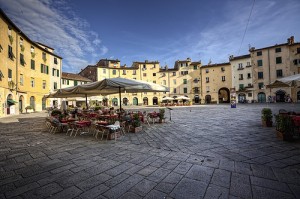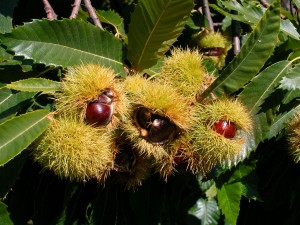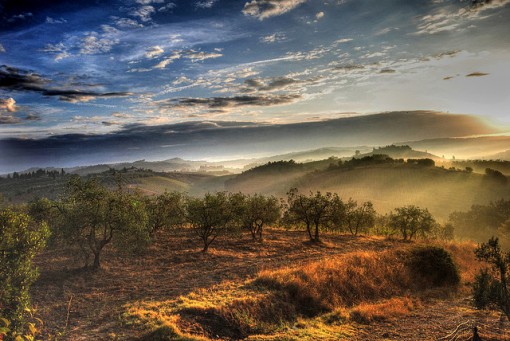This fall, I did something that I’ve done only once before in three decades of writing: for two whole weeks I booked off work and took a real vacation. Freelance writers can rarely afford half-month-long holidays. But I had spent a good part of 2010 in cardiac wards, tending to my visibly failing father and watching his fellow patients shuffle down the corridors clutching small oblong pillows to their chests. The pillows reminded them of the incisions from their open-heart surgery, and hence their physical limitations. My father, too, hugged one of those pillows. But open-heart surgery could not fix what was ailing him.
After his funeral, I realized that I needed to take time off and go somewhere far away from the haunted faces of those corridors. So I chose a destination that seemed to brim with joie de vivre, a kind of anti-cardiac ward—the small medieval town of Lucca in Italy. It didn’t hurt that Lucca lay in one of the heartlands—so to speak—of the Mediterranean Diet. I was interested in that diet. A family history of early heart disease increases one’s risk.
 Like everyone else, I’d read about the beneficial effects of large dollops of vegetables and fruits and fish, all splashed down with olive oil and a glass of red wine. And there was considerable scientific evidence to back claims for this diet. Indeed, a meta-analysis published in BMJ in 2008 revealed that an adherence to such a Mediterranean diet could reduce mortality from cardiovascular disease by 9 percent.
Like everyone else, I’d read about the beneficial effects of large dollops of vegetables and fruits and fish, all splashed down with olive oil and a glass of red wine. And there was considerable scientific evidence to back claims for this diet. Indeed, a meta-analysis published in BMJ in 2008 revealed that an adherence to such a Mediterranean diet could reduce mortality from cardiovascular disease by 9 percent.
I found the Mediterranean diet an easy one to love. But after two weeks in Lucca, I began to wonder if researchers had overlooked another key element of this diet. While people don’t talk about it much, the chefs of Tuscany have long made extensive use of nuts—chestnuts to be exact—even in the creamy soft texture of their pastas.
I discovered this while out roaming the Tuscan countryside with Emilio Bertoncini, an agronomist from Lucca. Bertoncini is a passionate advocate of traditional Tuscan agriculture and he has recently begun offering guided hikes in a region he knows well. Chestnuts, he explained, during a 5-hour trek around the base of Monte Pisano, have long been a staple of Tuscan cuisine. “My father used to say, Michelangelo is important, but for us, chestnuts are everything,” he quipped.
Each fall, Tuscany’s chestnut groves produce a reliable harvest, and farmers recognize dozens of varieties of the shiny brown chestnuts, each with its own subtle flavour and own name—from tigolese and pistolese to marroni. While some families regularly roast or boil these nuts, others dry them slowly in smoky wood ovens and then grind them in traditional water-powered mills to make a fine chestnut flour. With this, they make chestnut-based polenta, pasta, pastries and cakes.
Near the end of the Second World War, when German troops occupied northern Italy, chestnuts became a saving grace of Tuscan farmers, said Bertoncini. Starving German soldiers scoured the countryside for food, confiscating livestock whenever they could. Local families tried to hide their cattle and chickens but all the mooing and clucking tended to give them away. The occupiers, however, knew little about chestnuts, so they left the groves untouched. The Tuscans survived.
 Could some chestnut-based foods be part of the healthy Mediterranean diet? I certainly wouldn’t advocate anyone with nut allergies diving into such dishes. But I’d personally like to know more about these foods. According to data compiled by the U.S. Department of Agriculture (USDA), European roasted chestnuts possess less than three percent saturated fat and are very low in sodium and cholesterol. More strikingly, they possess complete, high-quality protein, with an optimal distribution of amino acids, and rank high in dietary fibre. Last but not least, USDA data shows that they are high in Vitamin C, Vitamin B and folate. In other words, chestnuts are pretty damn nutritious.
Could some chestnut-based foods be part of the healthy Mediterranean diet? I certainly wouldn’t advocate anyone with nut allergies diving into such dishes. But I’d personally like to know more about these foods. According to data compiled by the U.S. Department of Agriculture (USDA), European roasted chestnuts possess less than three percent saturated fat and are very low in sodium and cholesterol. More strikingly, they possess complete, high-quality protein, with an optimal distribution of amino acids, and rank high in dietary fibre. Last but not least, USDA data shows that they are high in Vitamin C, Vitamin B and folate. In other words, chestnuts are pretty damn nutritious.
I suspect that there’s a lot left to learn about the Mediterranean Diet. And as our population ages, and as baby boomers are transformed into seniors, we need to do all we can to reduce the numbers of patients clutching pillows in cardiac wards.
Photos: Upper, La nebbia di settembre, Tuscany. Francesco Sgroi. Middle, Piazza Anfiteatro, Lucca, courtesy Pynomoscato. Bottom, Chestnuts, Emilio Bertoncini.

That did it, Heather. I’m going.
Doesn’t take much encouragement, does it? Our doctors should be prescribing two-weeks in Tuscany for what ails us.
It is worth noting, all the same, that the concentration of chestnut growth and consumption on Tuscany is quite extreme; it’s much less of a staple in other parts of the Mediterranean, though it has spread in recent centuries. Are the nuts part of the beneficial diet? The study you link doesn’t mention them, but then “vegetables, fruits, legumes, cereals, fish, and a moderate intake of red wine during meals” could cover a multitude of
sinsrecipes…Jeremy, I’m always getting sins and recipes mixed up too.
The italians have a dish known as ‘Nipples of Venus’. It consists of chestnuts, coated in dark chocolate, laced with liqueur.
They were considered, wuite literally, the food of the Gods, and by Jimminy, they’re fine.
What an beautiful name for a dessert! I’m in awe of Italian cuisine on so many levels!